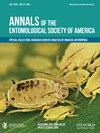Darwin's and Wallace's Fascinations With Oversized Morphology and the Question of Developmental Plasticity
IF 1.8
3区 农林科学
Q1 ENTOMOLOGY
引用次数: 0
Abstract
Abstract Darwin in his book, The Descent of Man and Selection in Relation to Sex, described his fascination with a male Chiasognathus grantii Stephens (Coreptera, Lucanidae), a stag beetle species with enormous mandibles. Wallace in his book, The Malay Archipelago, recorded his enchantment with a male Euchirus longimanus L. (Coreptera, Scarabaeoidae), a ‘chafer’ species with ‘immense fore-arms’ (tibia or femora). These oversized traits have been interpreted as the results of allometry through sexual selection. Both Darwin and Wallace were aware that there was a large variation in these oversized traits intraspecifically, leading to the question of the role of variability in species-level evolution. To answer this question, I studied the variation in developmental plasticity (DP; the individual ability to react to external environment) of the stag beetles, which shows a great variation in external morphology. These observations indicated that 1) DP (measured in body length) is independent of allometry of the mandibles, 2) allometry of the mandibles had been ingrained in most members of the Family before the differentiation of DP took place, 3) DP is indirectly related to sexual selection through elongated mandibles that are used for fighting or securing the mate, as evidenced by the close correlation of DP with the mandible length, and 4) the enormous mandibles of stag beetles are the product of enlarged DP through allometry and sexual selection. From these results, I add enhanced DP as an independent element in the evolution of seemingly oversized traits seen in many beetle species.达尔文和华莱士对超大形态的迷恋和发育可塑性问题
摘要达尔文在其著作《人类的起源和与性别有关的选择》中描述了他对雄性灰蝶的迷恋,灰蝶是一种有着巨大下颚的鹿角甲虫。Wallace在他的书《马来群岛》中记录了他对雄性长鳍真螯鹬的迷恋。这些过大的特征被解释为通过性别选择进行异速测量的结果。达尔文和华莱士都意识到,这些超大型性状在种内有很大的变异,这导致了变异在物种水平进化中的作用问题。为了回答这个问题,我研究了鹿角甲虫发育可塑性(DP;个体对外部环境的反应能力)的变化,这表明外部形态有很大的变化。这些观察结果表明,1)DP(以身体长度测量)独立于下颌骨的异径测量,2)在DP分化之前,下颌骨的异距测量已经在大多数家庭成员中根深蒂固,3)DP通过用于对抗或确保配偶的细长下颌骨与性选择间接相关,DP与下颌骨长度密切相关,证明了这一点。4)鹿角甲虫巨大的下颌骨是通过异径测量和性别选择扩大DP的产物。从这些结果中,我添加了增强的DP,作为许多甲虫物种中看似超大特征进化的一个独立元素。
本文章由计算机程序翻译,如有差异,请以英文原文为准。
求助全文
约1分钟内获得全文
求助全文
来源期刊
CiteScore
4.90
自引率
0.00%
发文量
25
审稿时长
6-12 weeks
期刊介绍:
The Annals of the Entomological Society of America exists to stimulate interdisciplinary dialogue across the entomological disciplines and to advance cooperative interaction among diverse groups of entomologists. It seeks to attract and publish cutting-edge research, reviews, collections of articles on a common topic of broad interest, and discussion of topics with national or international importance. We especially welcome articles covering developing areas of research, controversial issues or debate, and topics of importance to society. Manuscripts that are primarily reports of new species, methodology, pest management, or the biology of single species generally will be referred to other journals of the ESA. The most important criteria for acceptance are quality of work and breadth of interest to the readership.

 求助内容:
求助内容: 应助结果提醒方式:
应助结果提醒方式:


